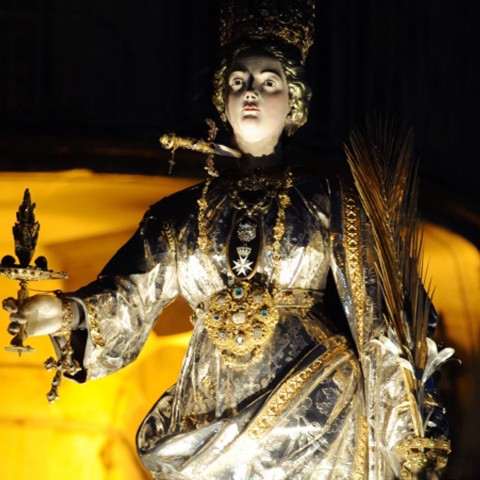St. Lucy’s Day is a festive, cozy holiday in Denmark, celebrated not long before Christmas each year. In this article, you’ll learn all about St. Lucy’s Day, from who Lucy was to how Danish people celebrate the holiday today.
At DanishClass101.com, we aim to make every aspect of your language-learning process both fun and informative—starting with this article!
Are you ready? Let’s go.

1. What is St. Lucy’s Day?
The Danish celebrate St. Lucy’s Day in the same month as Christmas, but don’t be fooled! This holiday, and the woman it’s named after, really have nothing to do with Christmas.
So who was Lucy? Read the following Danish text to find out, and then test your reading skills against the English text directly below it.
—
Legenden siger, at Lucia var en ung kristen kvinde, som nægtede at tilbede den romerske kejser og blev derfor dræbt og døde som martyr. Hun hjalp de fattige og syge, og det siges, hun bar lys på sit hoved, så begge hænder var frie.
The legend says that Lucy was a young Christian woman who refused to worship the Roman emperor, and as a result, was murdered and died a martyr. It’s claimed that she carried a light on her head when she cared for the old and sick to ensure her hands were free.
2. When is the Feast of St. Lucy?
Each year, the Danish celebrate the Feast of Saint Lucy on December 13.
3. St. Lucy’s Day Celebrations & Traditions
How do the Danish celebrate Saint Lucy’s Day?
On St. Lucy’s Day, Denmark’s main event is the St. Lucy’s parades in kindergartens and elementary schools.
A St. Lucy’s parade involves kids dressing in white gowns with a red band around their waist, each with a lit candle and guided by a “St. Lucy’s bride.” The front guide representing St. Lucy is usually a girl, but could also be a boy. The St. Lucy’s bride carries a crown or a wreath on her head with four lit candles.
During the St. Lucy’s parade, a song about Lucy is played; this song explains how Lucy brings light to the darkness and spreads joy. After the parade, everyone eats Lucy-bread, which are sweet wheat rolls with a taste of saffron.
Oftentimes, these Saint Lucy celebration parades aren’t limited to the school. Rather, the children take their parade through nursing homes, churches, and even in the streets in order to further spread the holiday spirit!
Naturally, the adults who accompany the St. Lucy’s parades are nervous about the burning candles that the kids carry in their hands. This is why they always stand by with a bucket of water in case the candles’ flames light anything on fire.
Churches will usually hold some kind of special Christmas-related event during this holiday to attract more people on St. Lucy Feast Day.
4. Longest Night of the Year
Now that you know about Saint Lucy’s Feast Day, do you know what they call the night of December 13 and 14?
They call it Lussenatten—a name that originates from Sweden, where Lussenatten, according to the Julian calendar, was the longest night of the year. But in the morning, while it was still dark, one would wake up to Lucy (or the young girl on the farm) standing by their bed with food and drink on a tray.
5. Essential St. Lucy’s Day Vocabulary
Here’s some vocabulary you need to know for Saint Lucy Day in Denmark!
- Hvid — “White”
- Brød — “Bread”
- Skole — “School“
- Kirke — “Church”
- Sang — “Song”
- Lys — “Light”
- Italiensk helgeninde — “Italian female saint”
- Martyrdød — “Martyrdom”
- Årets korteste dag — “Shortest day of the year”
- Optog — “Procession”
- Brud — “Bride”
- Krone — “Crown”
To hear each of these vocabulary words pronounced, and to read them alongside relevant images, be sure to visit our Danish St. Lucy’s Day vocabulary list!
Final Thoughts
What are your thoughts on St. Lucy’s Day? Are there similar holidays or celebrations in your country during December? Let us know in the comments; we always love hearing from you!
Learning about a country’s culture may be the most fascinating and enriching aspect of trying to master its language. If you want more information about Denmark and her people, or perhaps some more wintery vocabulary, you may find the following pages useful:
- Top 5 Things You Need to Know About Danish Pop Culture
- All About Danish Culture and Society
- Fars Dag: How to Celebrate Father’s Day in Denmark
- Words for Winter Snow Days
- Must-Know Christmas Day Vocabulary
Learning Danish doesn’t have to be a boring or overwhelming process—with DanishClass101.com, it can even be fun!
If you’re serious about mastering the language, but don’t have time any unnecessary hassles, create your free lifetime account today!
















